The Julia Child rose, also known as the “Buttergold” rose, is a floribunda rose that was introduced in 2004 by the American rose breeder Tom Carruth. This rose was named after the famous American chef Julia Child, who was a cooking teacher, author and television personality.
The rose has large, buttery yellow blooms, which have a classic, old-fashioned shape and are produced in clusters of about 3 flowers per stem. The blooms have a mild, sweet fragrance with a hint of licorice.
This rose has a medium-sized growth habit, reaching a height of 2 to 4 feet. The Julia Child rose is a repeat bloomer, producing waves of flowers throughout the growing season from late spring to fall. It is a hardy rose, suitable for growing in USDA zones 4-9.

Facts About Julia Child Rose
| Scientific Name | Rosa ‘Julia Child’ |
| Type of Rose | Floribunda Rose |
| Origin | United States |
| Year of Introduction | 2006 |
| Breeder | Tom Carruth in 2004 |
| Size | 2 to 4 feet in height |
| Foliage | Bright-green |
| USDA Zones | 4-9 |
| Marketing Names | ‘Soul Mate’, ‘SASOL Rose’ or ‘Anisade’ |
| Awards | All American Rose Selections (AARS) in 2006, Gold Star of the South Pacific in 2011. |
How to grow and care for the Julia Child rose
Planting:
- Choose a well-drained location with at least 6 hours of sunlight per day.
- Ensure good air circulation to prevent diseases.
- Plant the rose in a hole twice as wide and deep as the root ball.
Soil:
- Provide well-amended soil with organic matter.
- Aim for slightly acidic to neutral soil (pH 6.0-7.0).
Watering:
- Keep the soil consistently moist, especially during the growing season.
- Water at the base of the plant to prevent fungal diseases.
Mulching:
- Apply a layer of organic mulch around the base to retain moisture and suppress weeds.
- Mulching also helps regulate soil temperature.
Fertilizing:
- Fertilize in early spring with a balanced rose fertilizer.
- Repeat applications during the growing season according to package instructions.
Pruning:
- Prune in late winter or early spring before new growth begins.
- Remove dead or diseased wood, and shape the plant for better air circulation.
- Regular deadheading encourages continuous blooming.
Disease Control:
- Keep an eye out for common rose diseases like blackspot or powdery mildew.
- Use fungicides as a preventive measure, especially in humid conditions.
Pests:
- Monitor for pests such as aphids, thrips, or spider mites.
- Treat infestations promptly with insecticidal soap or neem oil.
Support:
- Provide support for the rose, especially if it grows tall or produces large blooms.
- Stake the plant to prevent damage from strong winds.
Winter Care:
- Mulch around the base of the rose to protect the roots from freezing temperatures.
- Consider wrapping the plant with burlap in colder climates.
Regular Inspection:
- Regularly inspect your Julia Child rose for signs of stress, disease, or pests.
- Early detection allows for timely intervention and better plant health.